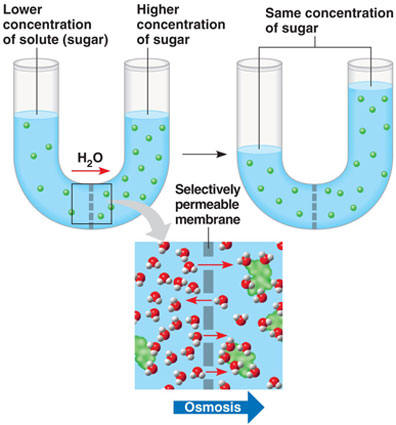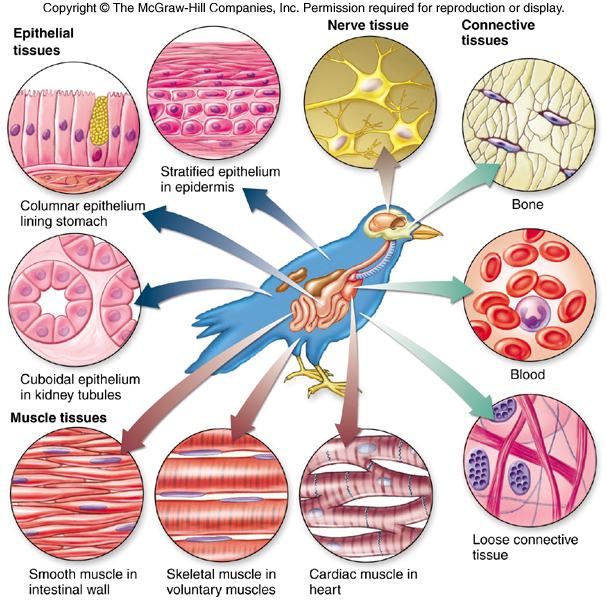Overview:
Living organisms share a number of properties. One of these properties is that they are all made from one or more cells. While some self replicating structures such as viruses and prions push the boundaries of our definition of what life is, in general they are not considered organisms.
Cells are the smallest unit of life, and each cell is a system nested within a system. In Grade 8, students will continue to develop their knowledge of organisms by focusing on the structure and function of cells in plants and animals. Our knowledge of cells has increased enormously
since the middle of the twentieth century, and students will examine the implications of this knowledge for individuals, society, and the environment.
Students will also be introduced to the use of microscopes. These are invaluable tools for scientists and provide students with opportunities to explore objects in amazing detail. Microscopes are precision instruments and must be handled with great care. It is important that students be able
to identify and explain the importance of practices for handling and using microscopes that not only respect the fragility of the tool but also ensure their personal safety and the safety of others.

Cell Theory
With the discovery of the microscope and related technologies, scientists started looking at the microscopic world. What they found was, that far from being lifeless the microscopic world was teeming with minute living things. By examining larger organisms at magnification they found that plants and animals share the same building strategy. In fact, all life shares these microscopic sub-structures we call cells. Some organisms were found to be so small as to consist of only one cell while others are made of more than one cell.
We can distinguish the following terms:
Unicellular: an organism made from only one cell
Multicellular: an organism made from more than one cell
Scientists have combined their findings in these three statements, which form what we call Cell Theory:
- The cell is the basic unit of life. A single cell is the smallest living thing that shows all the characteristics of life.
- Organisms can be a single cell (unicellular) or made more than one cell, even trillions of cells (multicellular).
- All cells are created from existing cells through the process of cell division by which a cell divides into two “daughter” cells.
Parts of a Plant Cell:
Nucleus: A large organelle that contains the genetic material and controls all functions of the cell.
Endoplasmic Reticulum (ER): A folded organelle that is responsible for making proteins. We distinguish smooth and rough Endoplasmic Reticulum. Rough Endoplasmic Reticulum has Ribosomes, smooth does not.
Golgi Apparatus: A folded organelle that collects, combines and distributes proteins inside or outside the cell.
Mitochondria: A membrane bound organelle that converts food into energy for use in the cell.
Vacuole: A large sac like organelle that stores excess water, food, waste and other substances, surrounded by a membrane.
Chloroplasts: Membrane bound organelles that contain chlorophyll. During photosynthesis, the chloroplasts use chlorophyll to convert water, carbon dioxide and light energy to make food (sugar).
Ribosomes: Tiny organelles that help make proteins. Found distributed within the cell and in particular attached to the Endoplasmic Reticulum.
Cytoplasm: A jelly like material that fills the cell.
Cell Wall: A rigid outer wall to provide structure to the plant cell which contains pores to allow the passage of materials.
Cell Membrane: A thin covering between the cytoplasm and the cell wall that controls what passes into or is released from the cell.
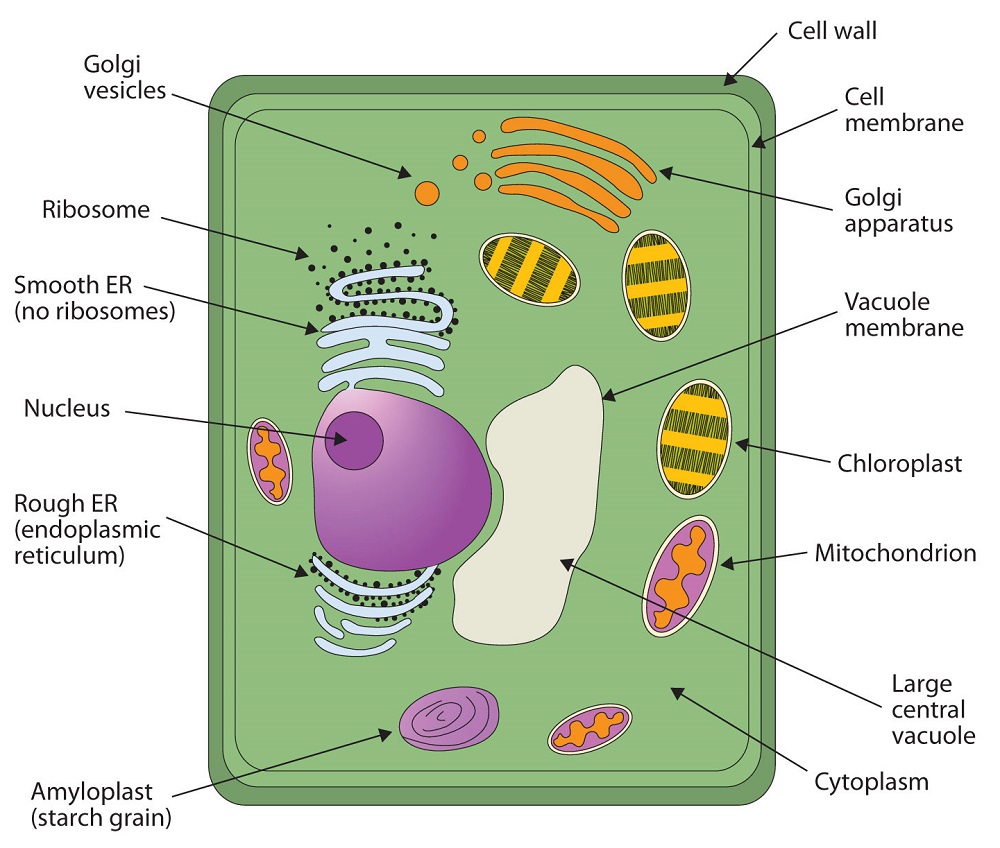
Parts of an Animal Cell:
Nucleus: A large organelle that contains the genetic material and controls all functions of the cell.
Endoplasmic Reticulum (ER): A folded organelle that is responsible for making proteins. We distinguish smooth and rough Endoplasmic Reticulum. Rough Endoplasmic Reticulum has Ribosomes, smooth does not.
Golgi Apparatus: A folded organelle that collects, combines and distributes proteins inside or outside the cell.
Mitochondria: A membrane bound organelle that converts food into energy for use in the cell.
Ribosomes: Tiny organelles that help make proteins. Found distributed within the cell and in particular attached to the Endoplasmic Reticulum.
Lysosomes: Small sac like organelles that contain digestive enzymes designed to break down food and digest waste.
Vacuole: A sac like organelle that stores excess water, food, waste and other substances which is surrounded by a membrane. Animal cells have several small vacuoles instead of one large one.
Cytoplasm: A watery, jelly like material that fills the cell.
Cell Membrane: A thin covering surrounding the cell that controls what passes into or is released from the cell.
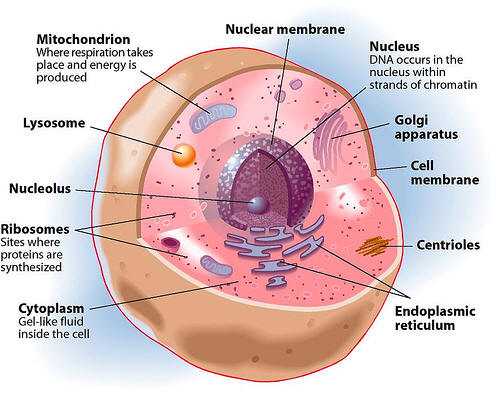
Cellular Transport
Like all living things, cells need to take in food, water and nutrients and eliminate waste. Many specialized cells also release materials for use in the body like for example cells in our pancreas that release insulin. These materials must be transported into and out of the cell and must migrate within the cell.
Diffusion:
Diffusion is the simplest form of cellular transport. It is the migration of particles from an area of high concentration of those particles to an area of low concentration. It is driven by the random movement of particles that facilitate the spreading of any free moving particle through Brownian motion. In simpler terms, any collection of particles eventually spreads itself evenly in the available space. The result of this is that if there is a high concentration of particles outside the cell (like oxygen in the blood in your arteries), those particles have a tendency to migrate into the cell by the sheer difference in numbers inside and outside the cell.
The reverse can also be true where an excess of particles is accumulated inside the cell (like carbon dioxide due to the consumption of sugar in the mitochondria) and those particles migrate out of the cell and are carried away by the blood. Diffusion is at work when you smell someone’s perfume or the aroma of a freshly cooked pizza while you pass a restaurant. While diffusion is effective as a means of transportation at the microscopic scale, it quickly becomes ineffective as the size of a cell increases. Hence, organisms needed to develop means of circulating materials through circulatory vessels once they reached a certain size.
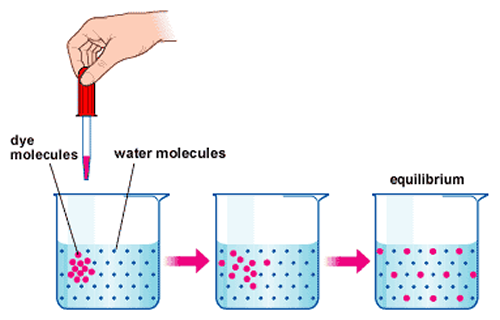
Osmosis:
Osmosis is a special form of diffusion that occurs across a membrane that allows some materials to pass (primarily water) but not others. Such a membrane is said to be semi-permeable. Since water is the primary substance that can migrate across the membrane, it is the concentration (amount) or water on each side of the membrane that determines in which direction water passes through it. Concentration of water can be changed by the amount of substances that are dissolved in it on each side. If dissolved substances increase on one side of the membrane, the relative amount of water decreases per volume. In such a case, water would tend to flow towards that side of the membrane. If, for example, we increase the salt level in the soil surrounding plant cell roots, water would tend to leave the plant cells and the plant wilts.
In the previous picture we see how osmosis causes water to migrate from left to right to equalize the relative amount of water compared to dissolved sugar. All this only works through a semi-permeable membrane. If the membrane was permeable to sugar, it would be the sugar rather than the water that would appear to migrate and the water levels would remain equal.
Hyper-, Hypo-, and Isotonic Environments:
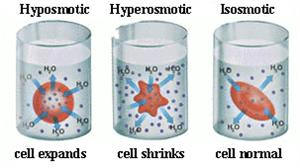
This is a pretty technical description but the images are good:
http://en.wikipedia.org/wiki/Tonicity
The difference in effect on animal and plant cells of solutions surrounding the cells depends on the presence or absence of the cell wall. Where a plant cell becomes “turgid” (that means firm) an animal cell may not survive and lyse (means burst, kaPOW, poof). The idea of tonicity has to do with the amount of dissolved substances (in our case salt) surrounding the cell. Hyper= more salt, hypo = less salt,
iso = same amount of salt compared to the inside of the cell.
The terms hyposmotic, hyperosmotic, etc. correspond to the terms that we have been using (hypotonic, hypertonic etc…)
Transformation of Energy:
Cells use three primary forms of energy transformation:
- Cellular Respiration
- Photosynthesis
- Chemosynthesis
We will discuss the first two:
Cellular Respiration:
Cellular respiration occurs in both plant and animal cells. It is the process by which organisms extract energy from high energy compounds like sugar molecules for use in the organism. Animal cells cannot make these high energy compounds and thus all animals must consume food to survive. Generally, these high energy compounds are converted into carbon dioxide and water and a high energy molecule called ATP ( Adenosine Triphosphate) which the organism uses as its major “energy currency”. ATP is used up during innumerable processes in the organisms metabolism such as transporting materials across the cell membrane, production of proteins and transcription of genetic material.
Photosynthesis:
During photosynthesis light energy is captured and used to convert carbon dioxide and water into sugar, a high energy molecule. Only plants are capable of doing this on our planet and almost all other life depends on this ability to provide these high energy molecules as food. During photosynthesis, photons are captured in the chloroplasts by a compound named chlorophyll. The stored energy is used during a multi-step process that slowly “ratchets” the energy level up to form sugars.
Chemosynthesis:
Chemosynthesis is related to photosynthesis insofar as it also produces organic molecules but instead of using light it uses the chemical power of reactive chemicals such as hydrogen sulfide (H2S) or ammonia.
Cell Division:
Cells die at a remarkable rate every day in our bodies. We heal injury, replace dead cells and while we grow, our cells multiply to form the increased size bones muscles etc… of our body. Cells build replacements and increase in numbers by a process called cell division (specifically in this case mitosis). The DNA in the nucleus doubles, lines up and then divides evenly into two parts together with the nucleus and the whole cell building two identical “daughter” cells from the parent cell.
http://www.youtube.com/watch?v=s1ylUTbXyWU
http://www.youtube.com/watch?v=aDAw2Zg4IgE&feature=related (check out the music 
(with regard to the videos: disregard the spoken information but instead focus on the visual of the DNA dividing into two equal, identical groups)
Animal and Plant Tissues:
Multi-cellular organisms have developed cells that perform specialized functions such as providing structural support, absorbing materials, production of substances, etc… . Generally, these specialized cells group with one another to form clusters of cells that we call tissues. In humans we distinguish the following major tissue types:
Connective Tissue:
Connective tissue connects and binds other tissues together. Connective tissues are often surrounded by extra cellular material that facilitates this structural function. Bone and blood are unusual forms of connective tissue
Muscle Tissue:
Muscle tissue provides motion to the body through contraction of specialized cells. It is separated into three main types of muscle types: smooth, skeletal, and cardiac muscle.
Nervous Tissue:
Nervous tissue provides control over the entire body. It transmits and receives impulses and processes information. The brain, spinal cord and nerves are made from this type of tissue.
Epithelial Tissue:
Epithelial tissue covers the body inside and out and all of the organs. It provides protection and facilitates the absorption of materials through our skin and in the intestinal tract.
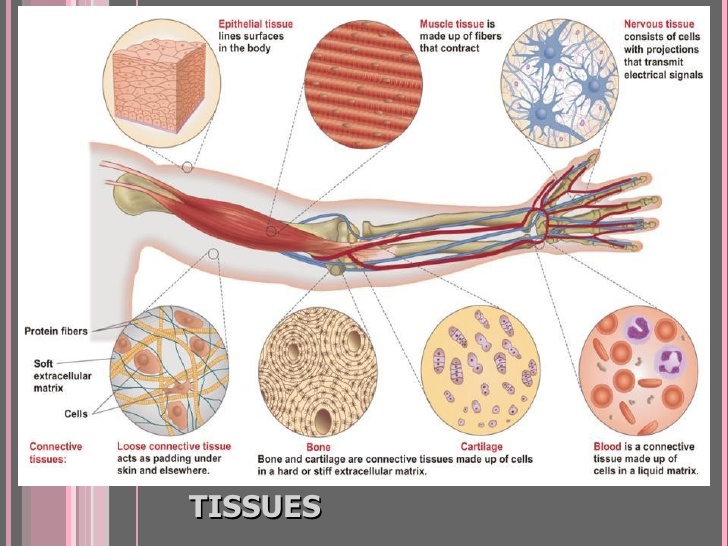
Plant tissues generally fall into three types of categories:
Protective, photosynthetic and transport tissues. Protective tissue covers the outside of the plant and protects from water loss, photosynthetic tissue generates the high energy compounds that the plant uses for food and transport tissues facilitate the distribution of water and nutrients.
Human Organ Systems:
Skeletal System:
The skeletal system is made of bone and cartilage. It’s purpose is to provide structure and protection to the body.
Muscular System:
The muscular system is made of muscles, tendons and ligaments. This system enables you to move and also moves substances through you digestive and circulatory system.
Circulatory System:
The circulatory system consists of the heart, blood vessels and blood. It delivers food and oxygen to our tissues and collects waste products from out cells.
Respiratory System:
The respiratory system consists of the nose, trachea and lungs. It’s purpose is to absorb oxygen from the air and to expel carbon dioxide from the body.
Nervous System:
The nervous system consists of the brain, spinal cord and nerves. It sends, receives and processes signals and controls the rest of the body.
Digestive System:
The digestive system consists of the mouth, salivary glands, esophagus, stomach, liver, gall bladder, pancreas, small and large intestines. It processes food by extracting nutrients and water and expels solid waste.
Excretory System:
The excretory system consists of the kidneys, ureters, bladder, and urethra. It filters our blood and removes excess water and liquid waste.
Integumentary System:
The integumentary system consists of skin, hair, nails and sweat (sebaceous) glands. It covers and protects the body and regulates body temperature.
Endocrine System:
The endocrine system consists of several hormone producing glands like the adrenal glands and portions of the pancreas. Hormones are tremendously powerful chemicals in our bodies that have significant regulative functions for the entire body. Functions such as the regulation of sugar in our blood or activity level and sleep cycles.
Lymphatic System:
The lymphatic system consists of lymph, lymph vessels, nodes and tissues. It is responsible for protection of the body from foreign organisms and abnormal cells.
Reproductive System:
The reproductive system consists of the male and female reproductive organs. It is responsible for the production of offspring.
Animal Cell Specialization Project:
Students research a specialized human cell and prepare a report on their findings for the class. The format of that report is up to the students to develop in conjunction with advice from Mr. Winkelhage. I have copied the handout to a file for you to download if you lost yours or were absent. A rubric is included.
Animal Cell Specialization Report
